Interview - The Eye of the Salamander : let’s talk with Pavel Nikolajev and Nick Karner
By Mulder, Los Angeles, 06 november 2024

In this exclusive interview, we uncover the magic behind The Eye of the Salamander, an indie gem that combines horror, sci-fi, and dark humor. Directed by Pavel Nikolajev, this compact 81-minute film follows a quirky archaeology professor who inadvertently awakens an ancient Aztec creature. Pavel and Nick Karner, who stars as the eccentric professor, join us to discuss the film's inspirations, challenges, and underlying themes.
Q: Pavel, what initially inspired you to explore Aztec mythology, and why did Xolotl resonate as a central figure for this story ?
Pavel Nikolajev: So basically, while working on the script, I had to choose between Egyptian and ancient South American civilizations. Both are well-known pyramid builders, but Aztec mythology appeared very compelling and probably not widely used for mainstream audiences. When researching this pantheon, Xolotl looked like the right creature to go with because he’s described as the god of fire and lightning and the soul guide for the dead—a very interesting figure, basically. He's depicted as a dark, skull-headed creature with reversed feet, which immediately caught my attention. It’s like, “Hey, who needs Egyptian civilization these days, right?” But seriously, the creature is something you wouldn’t want to encounter face-to-face in dark catacombs, so it was perfect.
Q: Pavel, the creature design is visually complex and unique. How did you approach creating something with reptilian, mammalian, and avian features ?
Pavel Nikolajev: First, I had to decide what kind of animal would have a skull-like face, and reptiles came to mind. But since reptiles, like dinosaurs or lizards, are heavily used in films—maybe overused—we decided to create a mixture of creature features. I’d say the body looks more like a mammal, with chicken legs and a reptilian head crowned by horns. This made it distinctive, something unique and scary for the audience, and that was the idea behind it.
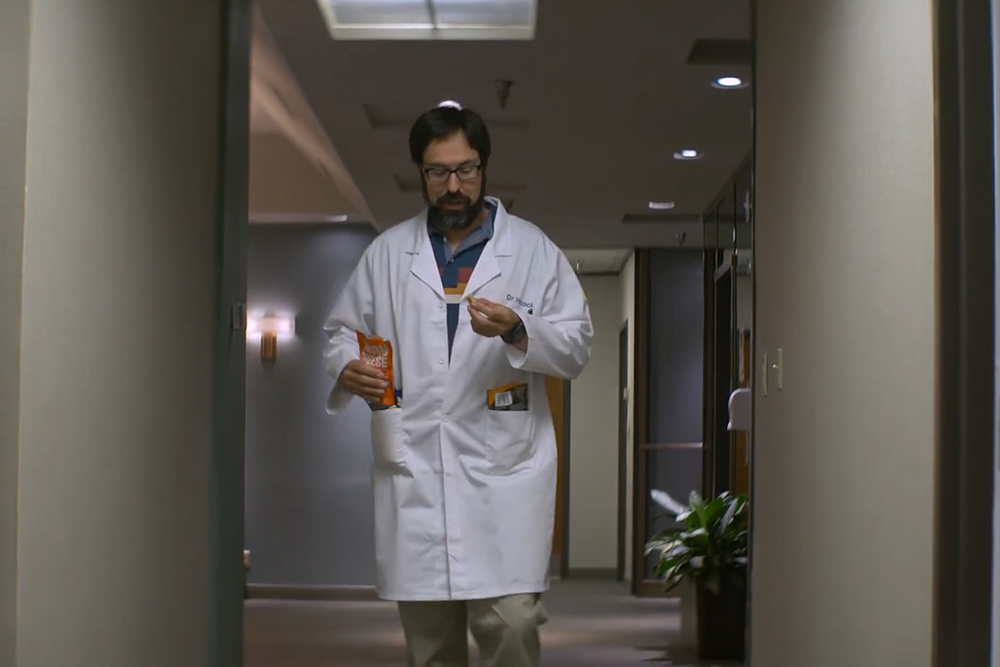
Q: Nick, your character balances academic rigor with a sense of recklessness. How did you prepare to portray this blend of curiosity and daring ?
Nick Karner: He’s clearly a goof-off who initially appears to take little seriously, but when he gets down to work, he’s still thoughtful, if unconventional. He knows his stuff, so I thought about the divergent qualities of intellectuals—like a doctor who’s really into RPGs or a master chef who’s obsessed with anime. I wanted to keep him sharp in his research but grounded in a less stringent mindset.
Q: Nick, how did you find working alongside such a physical, animatronic creature? What were some of the unique challenges in those scenes ?
Nick Karner: I don’t want to disappoint, but I didn’t have much interaction with the Xolotl creature in its full form because, of course, Pavel was inside the creature suit. Most scenes were relegated to inserts of clawed hands or the headpiece. There’s that emblematic still of me cringing as it gets up close and personal, but overall, I treated those scenes as a nice break from otherwise having no one else to bounce off except myself. Often, I was speaking either to myself or with myself in split screen. At our festival premiere earlier this year at the Nevermore Film Festival, I joked that my co-star, Xolotl, was a big diva—throwing temper tantrums, needing special dietary meals, not allowing eye contact, things like that. That was my interaction with it, basically.
Q: Pavel, how did you and cinematographer Blackett Bell establish the film’s distinct, shadow-heavy visual aesthetic ?
Pavel Nikolajev: That’s a good question. We shot both in gold mines and back in the studio. To match those settings, we decided to use a film noir lighting style, a well-known technique for hiding mismatches and making scenes feel very distinct. It also helped a lot because it added a dreadful look and feel to the catacomb scenes, bringing claustrophobia to the mix, in contrast to the bright museum offices. This turned out to be a wise choice because, in post-production, most of the mine and studio shots matched, so we didn’t have to do a lot of color grading or correction. The team did an excellent job, especially in the mines, where we had to deal with very dark conditions, operating the camera in humid and sometimes cold environments.
Q: Nick, how did you interpret the film’s dark humor, and were there any influences that helped you balance horror with comedy in your performance ?
Nick Karner: Pavel constantly reminded me, “This is a comedy, remember?” I love dark humor, and I have a high threshold for what’s possible or acceptable on film, so I rarely turn down an opportunity to get weird. Horror comedies are tricky—The Evil Dead or Return of the Living Dead came to mind. I thought, “Okay, these have a lot of physical comedy,” but Pavel treats the horror seriously, so I felt as long as the serious bits were respected, the comedy would fit naturally, keeping the tone consistent.
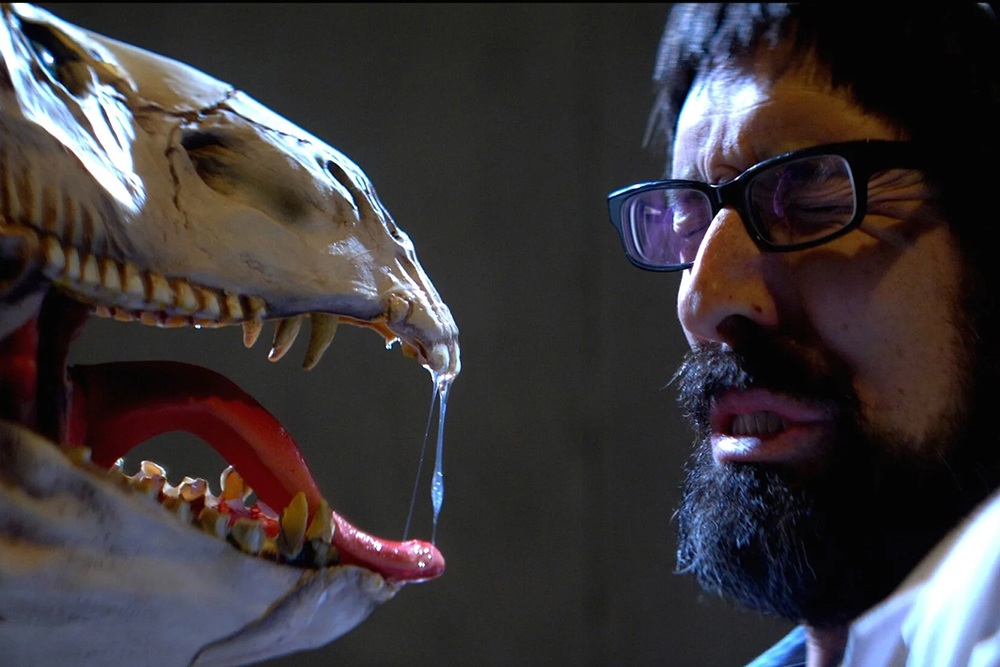
Q: Pavel, the creature's Tesla coil-inspired tail is a fascinating visual touch. What was the inspiration behind this detail ?
Pavel Nikolajev: One reason I chose Xolotl was that he shoots lightning, so we decided the device should look archaic or bizarre. First, we built a gun, tested it, but it didn’t work visually. Then I remembered Tesla coil stunts where people shoot each other with discharges—those clips fit perfectly. So, we built a battery to charge the body and went with a steampunk design, adding positive and negative canisters, cables, metal parts. Now Xolotl could shoot lightning through its limbs, and it worked great for us.
Q: Nick, the supernatural elements bring a shift to your character’s otherwise scientific worldview. How did you approach his reaction to this unfolding mystery ?
Nick Karner: There’s little preamble to what happens to his character; he just comes into the office, finds the artifact, and suddenly, this tablet appears. I felt like, because he represents the audience, it was fun for both me and the audience to figure out what was going on in real time. I tried to capture how someone would respond to a bizarre, cosmically strange situation—bewilderment leading to panic, acceptance, and eventually defiance against the monster and his entire situation.
Q: Pavel, how did Olga Polevaya’s involvement as producer help shape the production, especially considering the film’s limited budget ?
Pavel Nikolajev: Actually, Olga was the main reason the movie was finished. She handled everything from financing, scheduling, and locations to catering, continuity, and even makeup. In the scenes where you see Nick’s busted face—blame Olga. She’s handling the release and marketing now, and I honestly can’t complain; she’s doing an incredible job.
Nick Karner: Pavel, I heard there’s a salamander advertisement on a podcast today—yes, The Kingcast, a Stephen King podcast. It was very funny.
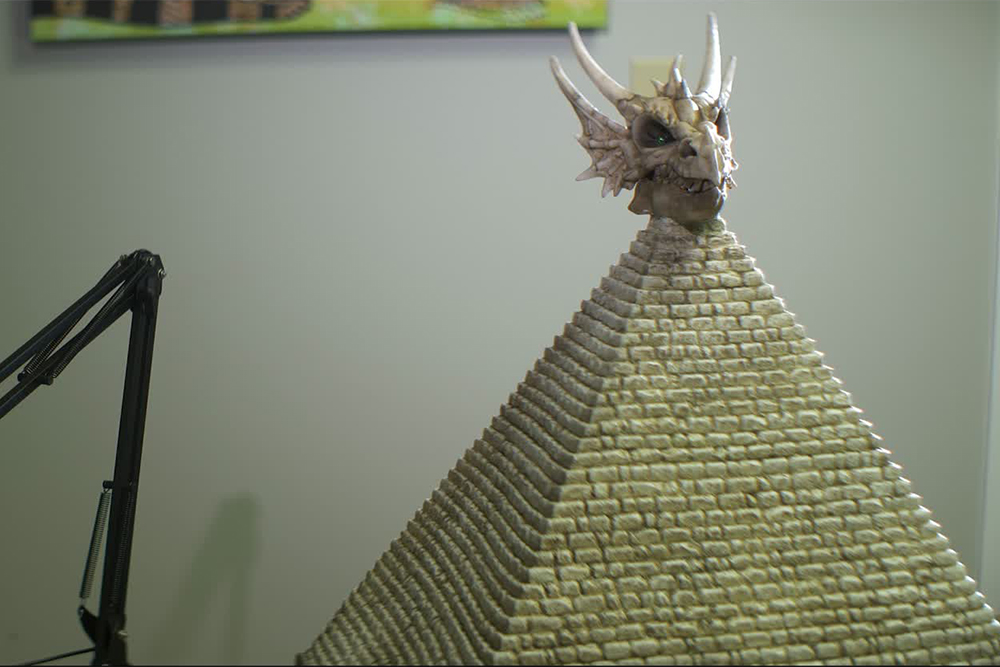
Q: Nick, with such a compact runtime, how did you work to convey your character’s evolution in a way that felt both dynamic and concise ?
Nick Karner: It helps when you’re constantly monologuing or talking to yourself. Pavel mentioned film noir, and a lot of those films featured voiceover. I never actually discussed with him whether a voiceover might have been an option—you know, we all know it didn’t really work out for Blade Runner when they added that strange voiceover. But I felt like every emotional beat had to be front and center. Hopefully, people sympathize with his (or my) plight and see how his character evolves from a slovenly coward to something vaguely resembling a hero.
Q: Pavel, the creature carries significant symbolic weight in the story. How does it represent ideas of retribution or transformation ?
Pavel Nikolajev: That’s a great question because Xolotl is a symbolic figure of punishment, reflecting the protagonist’s behavior and forcing him to reevaluate his life. Adding the creature into the mix makes it an attractive way to channel the story’s villainous spirit, making it a point of no return for the protagonist. As soon as you meet something like that, it changes you—so that was the main idea.
Q: Nick, what was it like portraying a character whose curiosity leads him into real danger? Did this role require a different approach compared to your past roles ?
Nick Karner: I enjoy playing flawed characters, and although I enjoy living vicariously through them—characters who might be self-confident, self-assured, or heroic—this role was unique. He’s entirely in over his head, with no one to shout out to or call for help. My prep work wasn’t just about the emotional beats but also practical necessities for the shoot, which was going to be complicated. I had to memorize dual dialogue scenes—one side was me, and the other side was also me. Luckily, I have some experience; I played clones in a film called Robert 39, a dystopian sci-fi film years ago. I did my usual routine—recorded all my dialogue in monotone so I wasn’t influenced by how I initially said the words. Then, I’d listen to it back until I had it memorized.
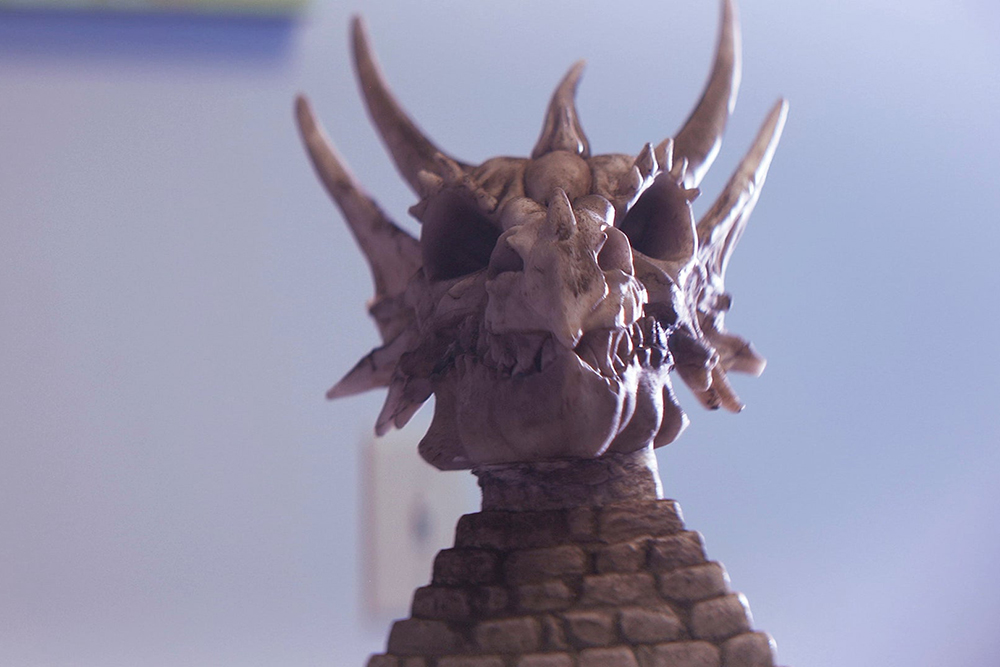
Q: Pavel, did your background in engineering contribute to the design and functionality of the creature's animatronics ?
Pavel Nikolajev: Yes, actually, it helped a lot. In this movie and my previous film, Headsome, we went with an ‘80s look and feel—those films stand out for their practical effects. For Headsome, I built a robotic eye with an animatronic head controlled by Bluetooth, saving time and money in post-production. For Salamander, I had to incorporate digital and animatronic elements, making the suit look real. Knowing how things connect and operate helped a lot—it saved us money. The person in the suit had to be me since I was the only one qualified to walk on those stilts!
Q: Nick, what message or takeaway do you hope audiences get from the professor’s journey through this supernatural experience ?
Nick Karner: I hope they have fun, and I hope they find it thrilling. The story is unpredictable, so I dare anyone who watches it to guess where it’s going! I think Pavel wrote a script that keeps you guessing. Yes, it embraces certain archetypal tropes—the unlikely hero conquering a force of cosmic horror—but I think people won’t know what’s coming next. At the Atlanta premiere, audience members mentioned that they didn’t know where it was going, and Pavel only slowly parcels out the information. My character gets zapped into this other place with no idea what’s going on, and I hope people leave having gone on that journey with him.

Q: Pavel, blending horror, sci-fi, and dark humor is a unique choice. What inspired you to combine these elements ?
Pavel Nikolajev: From the beginning, I wanted this to be more of an adventure than a horror story, to bring an adventurous spirit to the film. We even joked it was like Indiana Jones meets Doom. To keep the audience in the mood with occasional scares, I wanted the main character to be quirky, with the creature being grotesque rather than scary. It shouldn’t be just a genre film but a mix of adventure, scares, and humor. Everything has a scientific explanation at the end—this isn’t fantasy or mystery; it’s sci-fi.
Q: Pavel, could you talk about the process for composing the film’s eerie score and the impact you wanted it to have on viewers ?
Pavel Nikolajev: I wrote most of the score in pre-production since I had a clear idea of the film’s look, feel, and pace. I used modern techno beats to represent our current world and mixed in classical flute and cello chamber suites for the journey sections. This separated the two worlds and gave them distinct sounds. In scenes set in our world, you hear techno with electronic parts. In the catacombs, it’s mostly classical parts with a bit of electronic sound. That was the idea behind the score.
Nick Karner: Pavel, I didn’t know you wrote the music beforehand. We could have been like Sergio Leone and Ennio Morricone! You could’ve played it on set; that would have been fun.
Pavel Nikolajev: You never know if it’s going to work, but yes, it turned out well.
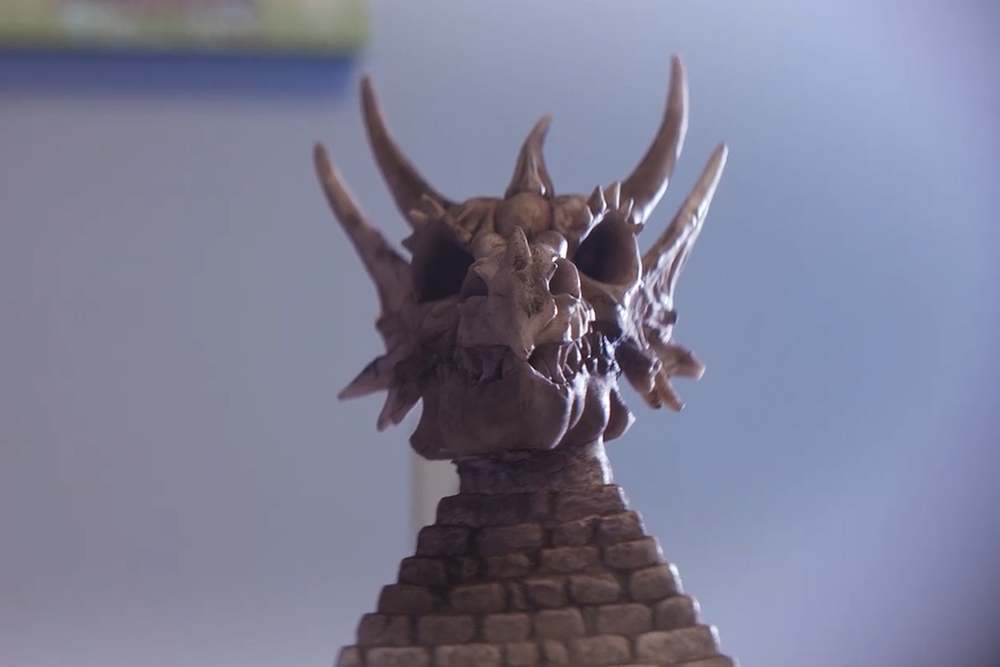
Q: Nick, the professor is almost a modern-day adventurer but with an academic twist. Did you draw from any classic film or literary inspirations for his character ?
Nick Karner: No specific inspirations, but I thought of him as an archetypal outsider thrown into a fantastical situation. I tried to make him an “everyman” of sorts—someone the audience can relate to.
Q: Pavel, what was the most challenging scene to shoot, either technically or creatively, and how did you overcome it ?
Pavel Nikolajev: Walking in the suit was exhausting. With the mask on, it’s hard to see and breathe through the small mouth opening. It’s rubber-based, so you’re sweating a lot. Plus, you have to balance on the stilts. It’s a challenge, and of course, you have to be in shape. The worst part was not being able to see myself while directing, but with insurance rates for stunts these days, I had to do it myself. It was challenging, but also fun.
Q: Nick, what lessons did you take from this role, both personally and professionally, given the film’s unique themes and genre blend ?
Nick Karner: I learned that it’s important to respect the balance between adventure, comedy, sci-fi, and horror. When interpreting a character, you have to stay true to the universe the writer and director have created. Pavel constantly reminded me, “Yes, this is a comedy, but we still want to care about this person, and this is still a serious situation.” It was rewarding to work on something so unique.
Synopsis:
A nutty archaeology professor puts his nose in the wrong Aztec artifact.
The Eye of the Salamander
Written and directed by Pavel Nikolajev
Produced by Olga Polevaya
Starring Seth Honzik, Nick Karner, Pavel Nikolajev
Music by Pavel Nikolajev
Cinematography : Blackett Bell
Edited by Pavel Nikolajev
Production companies : Nova Automatics Production
Distributed by Freestyle (United States)
Release date : November 1 2024
Running time : 81 minutes
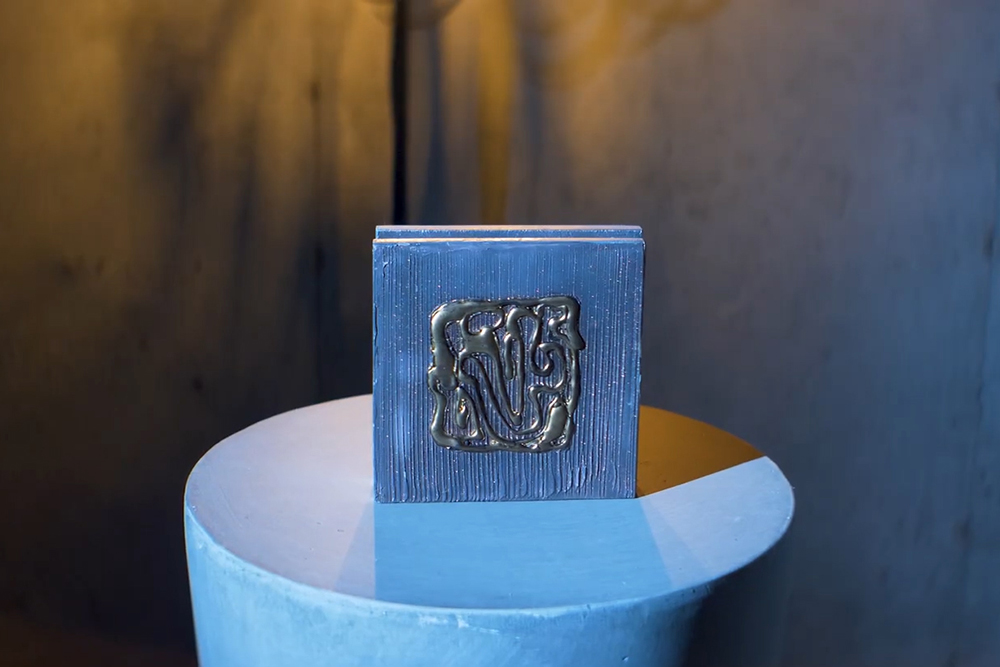
We would like to thanks the director Pavel Nikolajev and main actor Nick Karner for answering to our questions

